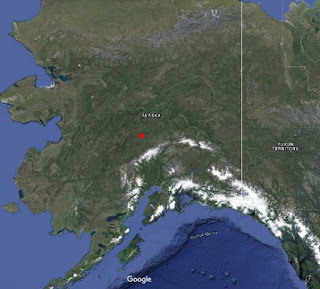 |
| courtesy: http://www.solarham.net/ |
As I usually do, I retuned my inverted - 'L' close to the CLE frequency range and set up my Perseus SDR to make overnight recordings every hour.
I capture two-minute files on the hour and during the best propagation times (usually from midnight to dawn), every half hour as well. The next day I review the files, tuning through the band to see what has been captured overnight. As you might imagine, this can take some time but it allows me to take advantage of any propagation peaks that I might have missed had I been listening in real time for just an hour or two. It also allows me to get a good night's sleep!
Conditions were noisy, on all three nights, with lightning activity over the western states ... but for the most part had cleared up nicely after midnight. The last night (Sunday) saw the best overall propagation, even with a K index of 2. A very nice, but short-lived opening towards the east, brought an additional 18 more catches that had not been heard on the first two evenings, along with some nice NDB signals from Ontario.
23 07:30 198.0 DIW Dixon, NC, USA
23 07:00 200.0 YJ Victoria, BC, CAN
23 07:00 200.0 UAB Anahim Lake, BC, CAN
23 07:00 200.0 5M Sparwood, BC, CAN
23 07:00 201.0 ZWN Winnipeg, MB, CAN
25 09:30 201.0 YKX Kirkland Lake, ON, CAN
25 09:00 201.0 GL La Grande Riviere, QC, CAN
23 10:00 203.0 ZKI Kitimat, BC, CAN
23 10:00 203.0 YBL Campbell River, BC, CAN
25 11:30 203.0 TCY Tracy, CA, USA
25 09:30 203.0 AB Aberdeen, SD, USA
23 10:00 204.0 ZQR Regina, SK, CAN
23 10:00 205.0 COR Corcoran, CA, USA
25 09:00 206.0 XBE Bearskin Lake, ON, CAN
24 12:00 206.0 SOW Show Low, AZ, USA
25 09:00 206.0 IIB Independence, IA, USA
23 10:00 206.0 EF Castlegar, BC, CAN
24 05:00 207.0 YNE Norway House, MB, CAN
23 04:00 207.0 PY Fort Chipewyan, AB, CAN
25 07:30 208.0 YSK Sanikiluaq, NU, CAN
25 10:00 209.0 ITR Burlington, CO, USA
23 07:00 209.0 IB Atikokan, ON, CAN
23 12:00 209.0 CYT Yakataga, ALS
23 06:00 211.0 HDG Gooding, ID, USA
23 06:00 212.0 YGX Gillam, MB, CAN
25 09:00 212.0 MPZ Mount Pleasant, IA, USA
23 12:00 212.0 CGL Juneau, ALS
23 06:00 214.0 LU Abbotsford, BC, CAN
23 10:00 215.0 ZAB Edmonton (Intl Apt), AB, CAN
25 09:00 215.0 AT Watertown, SD, USA
25 08:30 216.0 YFA Fort Albany, ON, CAN
23 07:30 216.0 GRF Fort Lewis, WA, USA
23 07:30 216.0 CLB Wilmington, NC, USA
23 12:00 217.0 EC Enoch, UT, USA
24 07:30 218.0 RL Red Lake, ON, CAN
23 12:00 218.0 PR Prince Rupert, BC, CAN
23 07:00 219.0 ZRS Regina, SK, CAN
23 07:00 221.0 QU Grande Prairie, AB, CAN
23 07:00 221.0 9A Hanna, AB, CAN
23 07:00 222.0 WY Wrigley, NT, CAN
25 09:00 223.0 YYW Armstrong, ON, CAN
23 07:00 223.0 YKA Kamloops, BC, CAN
23 12:00 223.0 AFE Kake Apt, ALS
25 09:00 224.0 MO Moosonee, ON, CAN
23 07:30 224.0 DN Dauphin, MB, CAN
23 07:00 225.0 X5 Vegreville, AB, CAN
23 12:00 225.0 LWG Corvallis, OR, USA
25 09:00 227.0 YAC Cat Lake, ON, CAN
25 11:00 227.0 MHM Minchumina, ALS
23 07:30 227.0 CG Castlegar, BC, CAN
23 07:30 227.0 9X Brooks, AB, CAN
23 12:00 229.0 AKW Klawock, ALS
23 09:30 230.0 YD Smithers, BC, CAN
23 09:30 230.0 VG Vermilion, AB, CAN
23 09:30 230.0 BI Bismarck, ND, USA
25 09:00 233.0 QN Nakina, ON, CAN
23 07:30 233.0 OKS Oshkosh, NE, USA
23 09:00 233.0 BR Brandon, MB, CAN
23 12:00 233.0 ALJ Hinchinbrook Island, ALS
24 07:00 236.0 ZHT Winnipeg IAP, MB, CAN
23 07:00 236.0 YZA Ashcroft, BC, CAN
25 09:30 236.0 JB Whitehorse, YT, CAN
24 07:30 236.0 FOR Forsyth, MT, USA
23 10:00 238.0 MPA Nampa, ID, USA
23 05:00 239.0 OJ High Level, AB, CAN
25 10:30 239.0 BBB Benson, MN, USA
 |
| courtesy: https://www.google.ca/maps/ |
Hopefully you can jump in for next month's CLE activity. The CLE 206 listening results for all North American listeners and those outside of Europe can be found here.

































